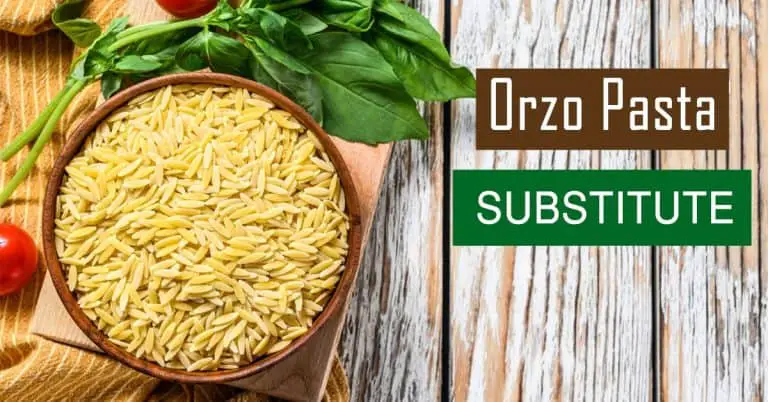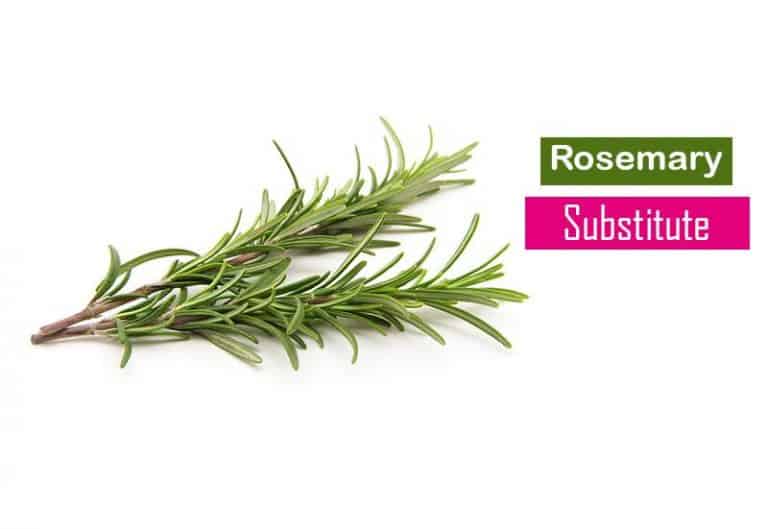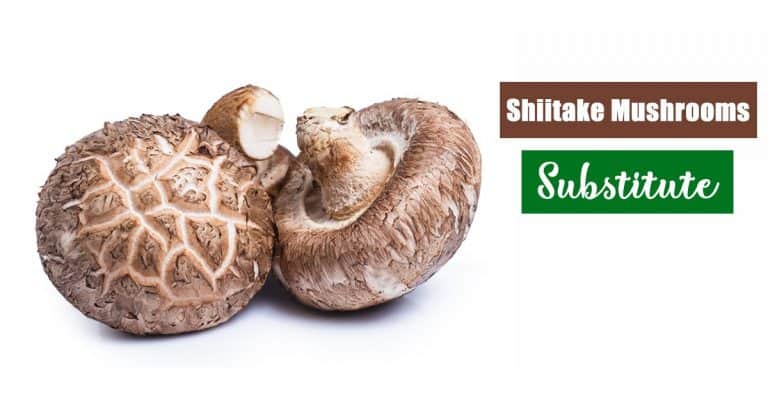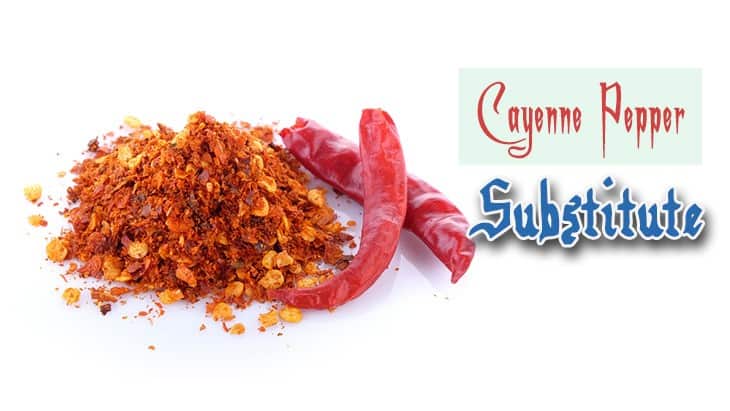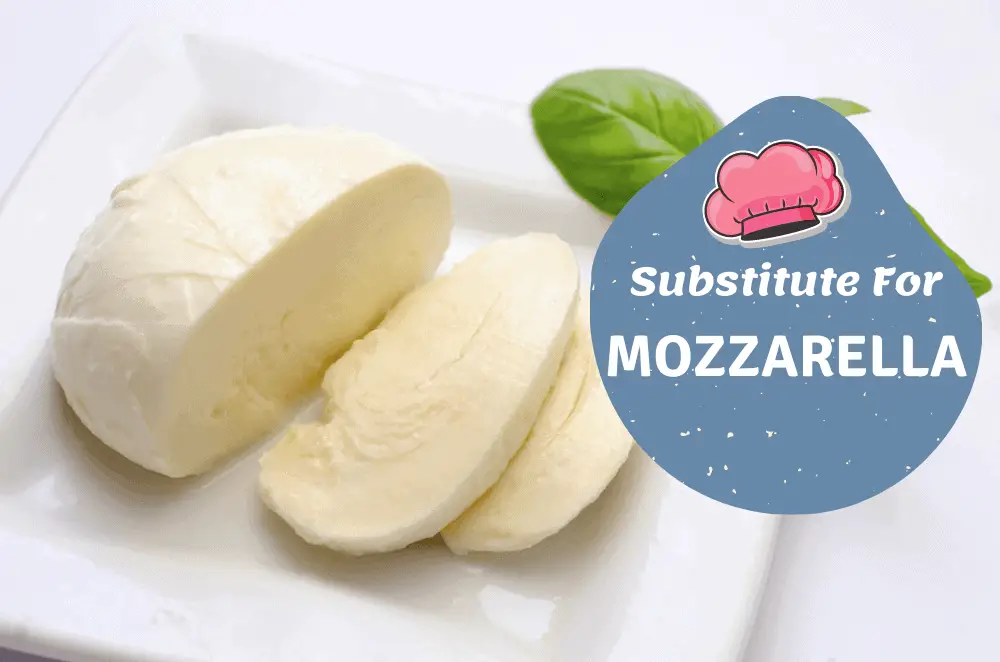
“What is the best substitute for Mozzarella?” If you need the answer to this question, you’ve landed in the right place!
Mozzarella is one of the most popular and favored cheeses not only in Italy but also many countries. You can easily find it on pizza, spaghetti, salad ingredients, hotdog, and so on as it significantly enhances your dishes’ taste and smell.
However, what can you use as an alternative for this type of cheese? We will show you 12 substitutes that you can replace Mozzarella with either one or more of them. Let’s get started!
What Is The Best Substitute For Mozzarella?
Each cheese type below has its signature suitable usage, texture, smell, and flavor that are worth considering carefully to find out your best alternative to Mozzarella.
1. Provolone
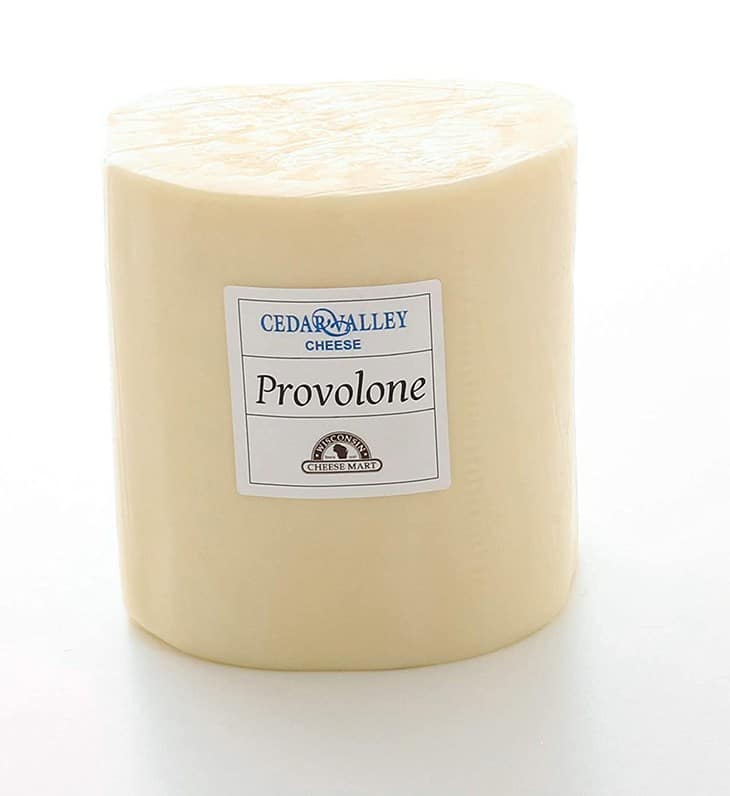
Many people say that Provolone is an aged version of Mozzarella. Certainly, there are some features that make them different, but overall, Provolone is always the best choice as a Mozzarella replacement.
The best Provolone cheese is from Casilli near Vesuvius, Italy. It was created and developed by the two ends of countries, thus requiring lengthy transportation. After a long period of transmission, it has the combination of flavors like at present.
It’s a semi-hard cheese, and after melting, this kind of cheese is stringier and stretchier than Mozzarella. You’ll receive a smooth and mild flavor with undertones of salt.
You can use this mild cheese for Lasagna, Pizza, or Caprese Salad. It would give you the most enjoyable flavor under shredded form as one of the substitutes for pizza topping.
Health benefits:
- Support bone growth
- Include Vitamin C, D, K, A
- Contain Magnesium and Zinc nutrients
Using: 2 to 3 weeks after opening.
2. Swiss

Perhaps you have seen pieces of cheese with many holes in cartoons growing up? They could be Swiss cheese! According to some research, these holes appear in the production process and don’t contain any substance that is harmful to the human body.
Manufacturers will drain curds, and the cheese can age by itself from 4 to 18 months. Lightly washing with brine is usually done during this period.
If you prefer a cheese type with a stronger flavor than Mozzarella, Swiss is an ideal choice as this cheese has a nutty and semi-sweet flavor. After melting, it possesses a creamy consistency.
The strong taste of this Mozzarella cheese substitute is suitable for Sandwiches, Pasta sauce, and Cheese sauce. Besides, nuts, fruits, and bread can give you the best meals when combined with melted or shredded Swiss.
Health benefits:
- Good for bone health
- Contribute to building muscle
- Low in lactose
Using: Less than 1 week after opening.
3. Cheddar

Similar to Mozzarella, Cheddar is also famous and sold globally. It makes up 51% of cheese consumption in England – the origin of this cheese (Cheddar Village, England).
The main ingredient of Cheddar is curd, stuffed with salt after being soaked in whey. It takes about 15 months from processing to getting aged and ready to use.
Firm, pungent, and earthy flavor undertone combined with a smooth texture are what you will receive when biting a piece of Cheddar. It’s special, and you may be taken aback the first time.
But enjoying cheese is an acquired taste, and it’s wonderful for different dishes when you get used to eating this substitute cheese.
Cheddar has a low elastic texture, so it can set quickly after melting. For that reason, both mild Cheddar and aged Cheddar are ideal choices for tasty Lasagna, Waffles, or even Soup (Beef and Cheddar Soup)
Health benefits:
- Lower cholesterol and lactose
- Suitable for vegans
- Reduce cavities and enhance teeth’s health
Using: Under 6 weeks in the refrigerator.
4. Gouda
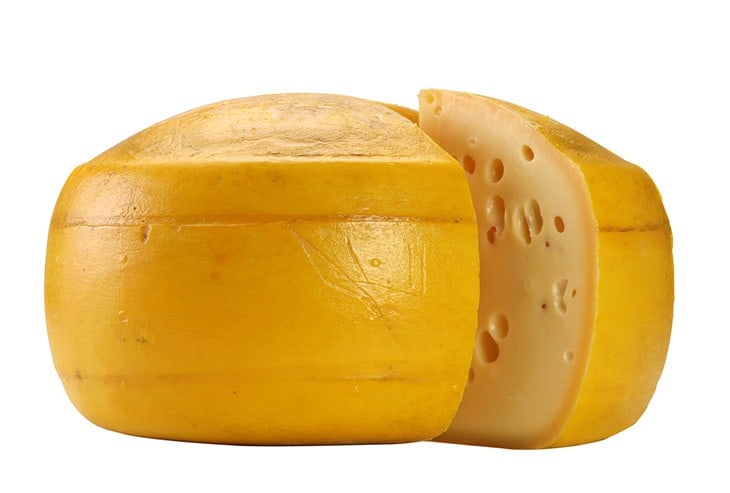
Gouda is cow’s milk cheese first produced in South Holland, Netherlands. You can easily distinguish this cheese as it has a deep yellow color and is usually sold in large pieces.
The texture and flavor of Gouda will change based on its ages. In the beginning, it’s semi-hard and becomes harder when aged (10 months or more).
If you prefer a mild and delicate flavor, young Gouda cheese is a wonderful choice. On the contrary, aged Gouda will have complex flavors with a sweet finish and nutty undertone.
The Dutch cheese can melt easily, making this Mozzarella alternative suitable for Sandwiches, Burgers, or any dishes that need cheese creamy flavor topping. You can also use this to make Prosciutto-Pesto, Tortellini Toss, and Apple Jack Crumb Pie.
Health benefits:
- High Calcium content
- Vegan cheese
- Contribute to combating nerve damage
Using: 2 to 3 weeks in the refrigerator.
5. Edam

Edam is quite similar to Gouda, especially in density and springy texture. However, you can easily spot the difference in taste and undertone to distinguish them.
This semi-hard cheese originated in the Edam province, Netherland. It’s easy to recognize with a flat-ended sphere shape, the yellow cheese inside, and a coat of red paraffin.
Young and aged Edam cheese have dissimilar flavors. Most of the Edam cheeses sold in the stores are “young” with mild and subtle flavor, and the smell is likely not dominant. The aged ones will have a firm texture, more smell, and a sharp taste.
It’s not only suitable for adding in your cheesy dishes but also a wonderful snack. If you haven’t had any idea, you can use the aged, strong-flavored Edam to make Crispy Cheese Choux, Cheese Sandwich, Lasagna Crisp, Cheese and Currant Wedges (or you can use a substitute for currant if you don’t like it)etc.
Health benefits:
- Fight bad cholesterol
- Good for metabolism
- Rich in Sodium and Phosphorus contents
Using: 3 to 4 weeks in the refrigerator.
6. Feta

Different from many kinds of cheese above, Feta cheese is made of sheep’s milk. Some manufacturers also combine sheep milk and goat milk to create a stronger taste.
It’s a Greek cheese with characteristic white color, small or no holes on the surface. Feta is usually formed into a large block with grainy textures and without skins.
Tangy and salty taste is the main feature of it. However, this Mozzarella substitute will change from mild and semi-sweet taste to a stronger flavor over time, which may surprise you at first.
Some ideal dishes with Feta cheese you can take a look at are Greek Cheese tasty salad, Spanakopita, Tomato Tart, Beet Galette, etc.
Using: Around 5 days in the refrigerator.
7. Ricotta
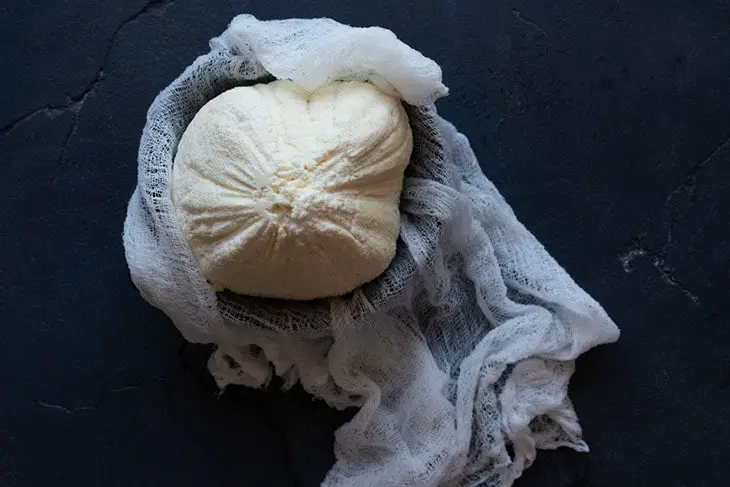
People in Italy use the whey leftovers after producing other types of cheese to make Ricotta. It can be the milk of cows, sheep, goats, or even buffalos.
While young cheese will have a soft texture, the aged one will be semi-soft. Instead of melting like others, this Italian white cheese only turns softer under the high temperature.
You can directly enjoy this popular cheese without cooking, and it will taste like fresh Mozzarella. Soft, mild, and sweet tastes are what you will receive when using both young and old cheese.
Ricotta is famous for making flavorful meals such as Cannolis dip or Crepe filling. Besides, Ricotta Cheesecake and Ricotta Pancake are also worth a try.
Health benefit:
- Rich in Vitamin A and K
- Supply EPA Omega-3 and DHA
- High in Selenium
Using: From 3 to 7 days in the refrigerator.
8. Jarlsberg

Compared to Swiss cheese, Jarlsberg has the same appearance with light yellow color. But the texture and taste differences make them unique and distinguishable.
This semi-hard cheese originated in Jarlsberg, Norway. However, Ohio and Ireland are the 2 countries that produce a large yield of this cheese each year.
There are some holes on the surface and in Jarlsberg pieces, and they help people determine the cheese’s age. The bigger the holes are, the older the cheese is.
For people who love the nutty flavor and semi-sweet taste, this type of cheese will satisfy you. After melting, it will be creamy and less stringy. You can enjoy it as a snack or combine it with others to make comforting meals like Croque Monsieur, Puff Pastry Swirls, Quiche, some baked dishes, and so on.
Health benefits:
- Reduce risks of cancer
- Prevent hardening of the Arteries
- Support bones and muscles
Using: Under 10 days in the refrigerator.
9. Monterey Jack
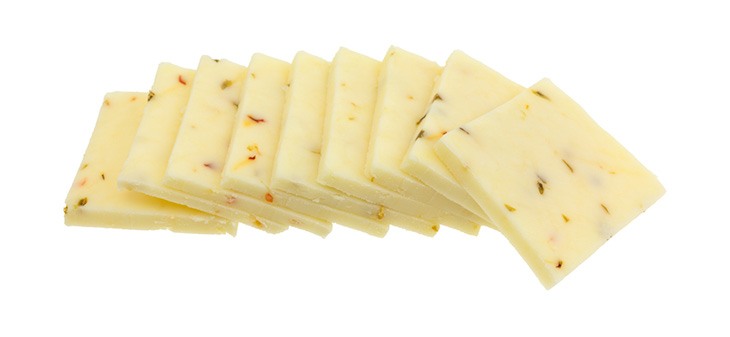
This made-in-USA cheese has a bright yellow color, with the main ingredient being cow’s milk. It’s a semi-hard type, but the young cheese is pretty soft and smells less.
Monterey Jack’s original version has mild flavor and is lightly sweet. Nevertheless, its variants have a more complex taste:
- Dry Jack: It tastes like regular Parmesan cheese with a harder texture.
- Pepper Jack: It has a bit peppery taste with the combination of peppers, chilies, and a touch of herb flavors.
- Blends: Mixture of origin Monterey Jack and Cheddar
This American cheese is combined in many different dishes. Tex-Mex Lasagna, Italian Chicken Pie, Three-Cheese Manicotti are what you shouldn’t ignore.
Health benefits:
- Rich in Vitamin D
- Supply necessary Protein
Using: From 1 to a couple of weeks in the refrigerator.
10. Oaxaca/Mexican Cheese
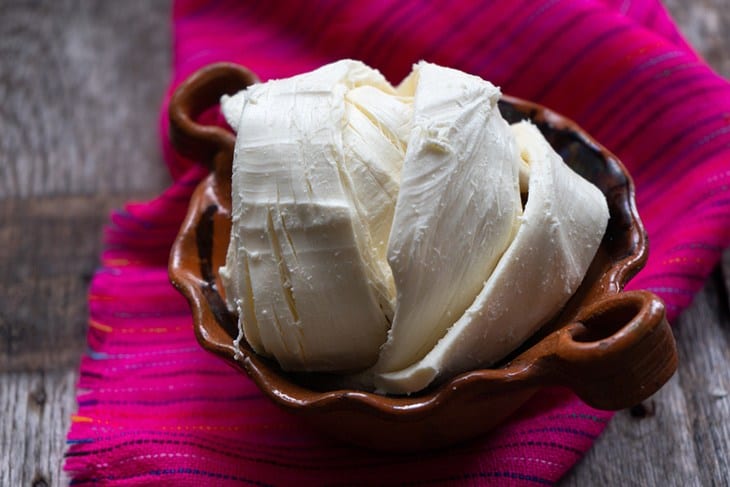
It’s one of the closest cheeses that we can choose as the best Mozzarella alternative. This Mexican cheese is semi-hard, and the aged cheese will be firmer.
About melting and springy properties, there isn’t too much difference between it and Mozzarella. After melting, this cheese will have a stretchy and stringy texture.
What makes this springy cheese different from Mozzarella is its buttery flavor and stronger taste. It’s suitable for making Blue Corn Tortilla, Oaxaca Cheese Pretzels, Salsa Melted Cheese, String Cheese Sticks, etc.
Health benefits:
- Rich in Calcium and Protein
- Low cholesterol
Using: 1 week to 10 days in the refrigerator.
11. Fontina

Fontina is an Italian semi-soft cheese but can change to a hard texture depending on the age.
When melting, it won’t be stringy or stretchy but creamy and soft. Also, it’s easy to melt at a low temperature, so you should store it in cold areas to keep it fresh.
The flavor of Fontina cheese ranges from a milder flavor than Mozzarella to medium-sharp. This cottage cheese’s smell and nutty taste are deeper and stronger than Mozzarella.
People usually eat the fresh Fontina as a topping for bread or a snack. Toast Farcito, Chicken Valdostano, Cheesy Tots, Zucchinis Roll-Ups are also ideal dishes to combine with.
Health benefits:
- Improve mental health
- Boost the immunes system
- Good for cardiovascular health
Using: Under 10 days in the refrigerator.
12. Parmigiano-Reggiano
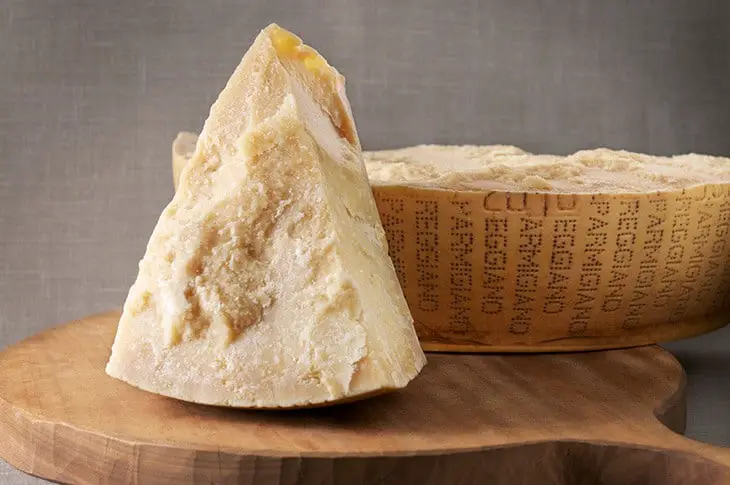
Parmigiano-Reggiano is one of the most traditional cheeses of Italy, which has appeared since the 13th to 14th centuries. Parmesan is another copycat version of it. It’s produced in a large wheel ranging from 7 to 18 inches in diameter.
Compared to Mozzarella, this cheese contains more oil and higher moisture content. When melted, it becomes soft and creamy texture but not stretchy.
It’s outstanding with the depth of flavor: buttery flavor and nutty undertone. This cheese will become sweeter and harder when it’s older.
Sprinkled over meals such as Pizza or Pasta are the most popular uses of this cheese.
In addition, you can try it with Kale Chips, Chicken Parmesan Recipe, or especially Cheesy Baked Tomatoes. You can look for a substitute for fire roasted tomatoes when you can’t make it at home.
Health benefits:
- Good source of fat and vitamin
- Full of Phosphorus, Zinc, and Copper
- Easily digestible
Using: About 5 to 6 weeks in the refrigerator.
Frequently Asked Questions
When finding a replacement, many questions may confuse us. We listed some of them out with detailed answers to give you a helpful hand.
What Is The Different Between Processed Mozzarella And Fresh Mozzarella?
Most of what you usually see, such as Mozzarella cheese sticks, Mozzarella in Salads, or Mozzarella in Lasagna, are processed. There are some differences between these 2 types:
Fresh Mozzarella
- Hand-molded into small balls
- Stored to keep fresh in whey or brine until it’s used
- Soft and has the original taste
- Better to use at room or cold temperatures
Processed Mozzarella
- Low-moisture and easy to be sliced and grated
- Can be stored in the bag at room or low temperature
- Chewy and heavy
- Suitable for hot food as it’s easy to smell
What Makes My Mozzarella Bitter?
Some reasons that make your Mozzarella cheese bitter:
- Out of date: in this case, you shouldn’t use it anymore as it can contain harmful bacteria that can cause dyspepsia (digestive problems).
- High moisture: Some homemade cheese that isn’t drained properly is easy to get mold and become bitter. So you want to pay attention to the storing method if you want to make fresh cheese and keep it for longer use.
- Not enough salt: This happens with homemade ones, and you can improve it by adding more salt to your cheese then mold them again.
How Long Should We Use Low-Moisture Mozzarella?
Different Mozzarella cheese types will have their using time. Some of popular duration we can mention are:
- Fresh, Shredded Mozzarella, and Burrata: keep no more than 5 days since opening the package in the refrigerator.
- Loaf Mozzarella: 21 days in the refrigerator after opening.
Smoked Mozzarella: 28 days in the refrigerator after opening.
Can We Freeze Mozzarella For Longer Using Time?
Absolutely! However, you have to pay attention to the freezing and thawing processes to keep the quality of cheese and prevent it from molding.
For freezing, you have to prepare a freeze bag and vacuum. After putting the cheese in, you have to remove all the air and seal it. Remember to label each bag as you will be able to know which you should use up first.
When you use it, take the cheese out of the frozen compartment to the cool compartment about one day before cooking. If you suddenly take it out at room temperature, your cheese can be spoiled and inedible.
Conclusion
Overall, we’ve revealed to you all the necessary information about the substitute for Mozzarella as well as the top list. Hopefully, you’ll find it helpful and supportive to have more wonderful dishes and solve the problem when you don’t have Mozzarella.
You can take a look once again at the top 12 cheese varieties:
- Provolone
- Swiss
- Cheddar
- Gouda
- Edam
- Feta
- Ricotta
- Jarlsberg
- Monterey Jack
- Oaxaca/Mexican Cheese
- Fontina
- Parmigiano-Reggiano
Each of the top substitutes for Mozzarella has different flavor profiles, textures and suitable for different dishes. Consider what you’re looking for to find out the best for yourself.



